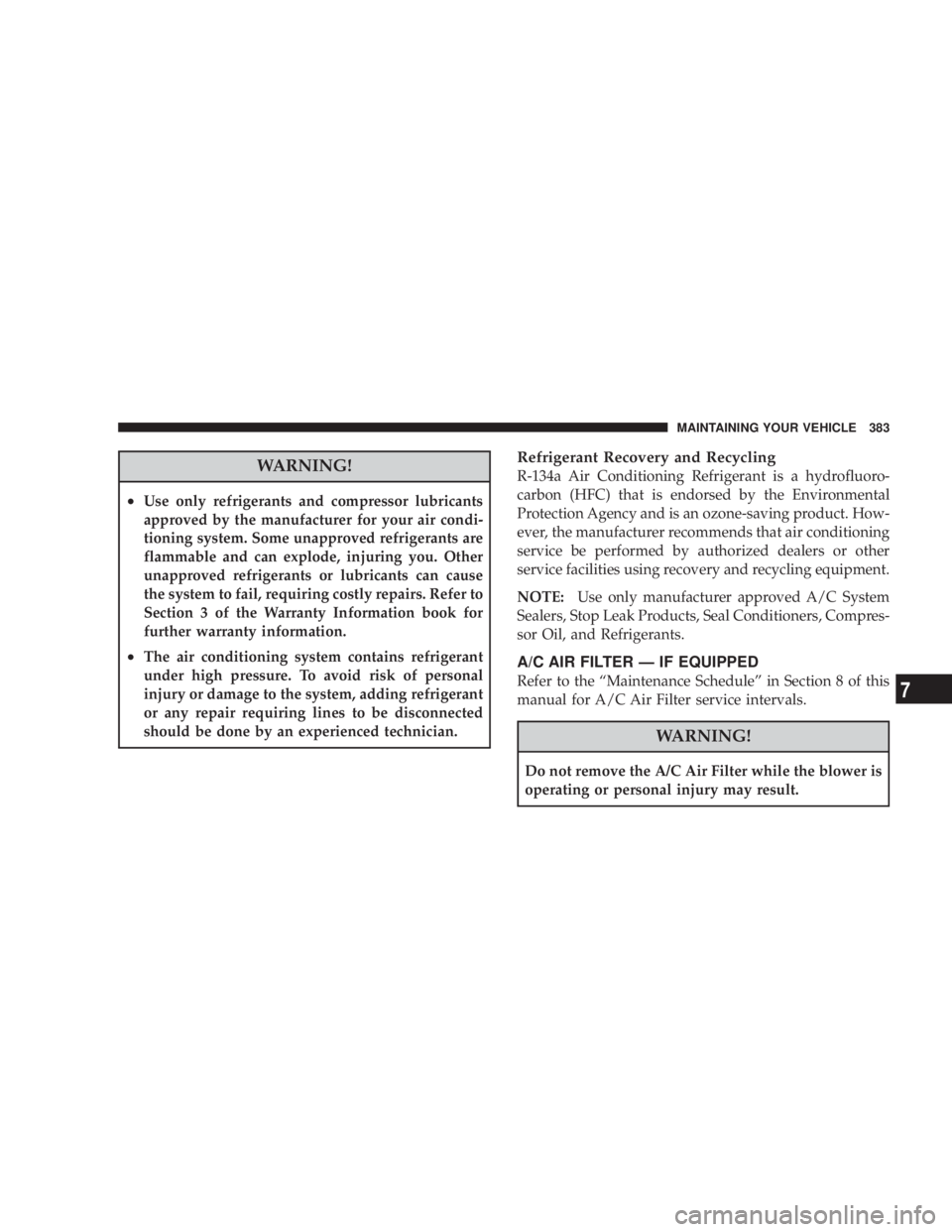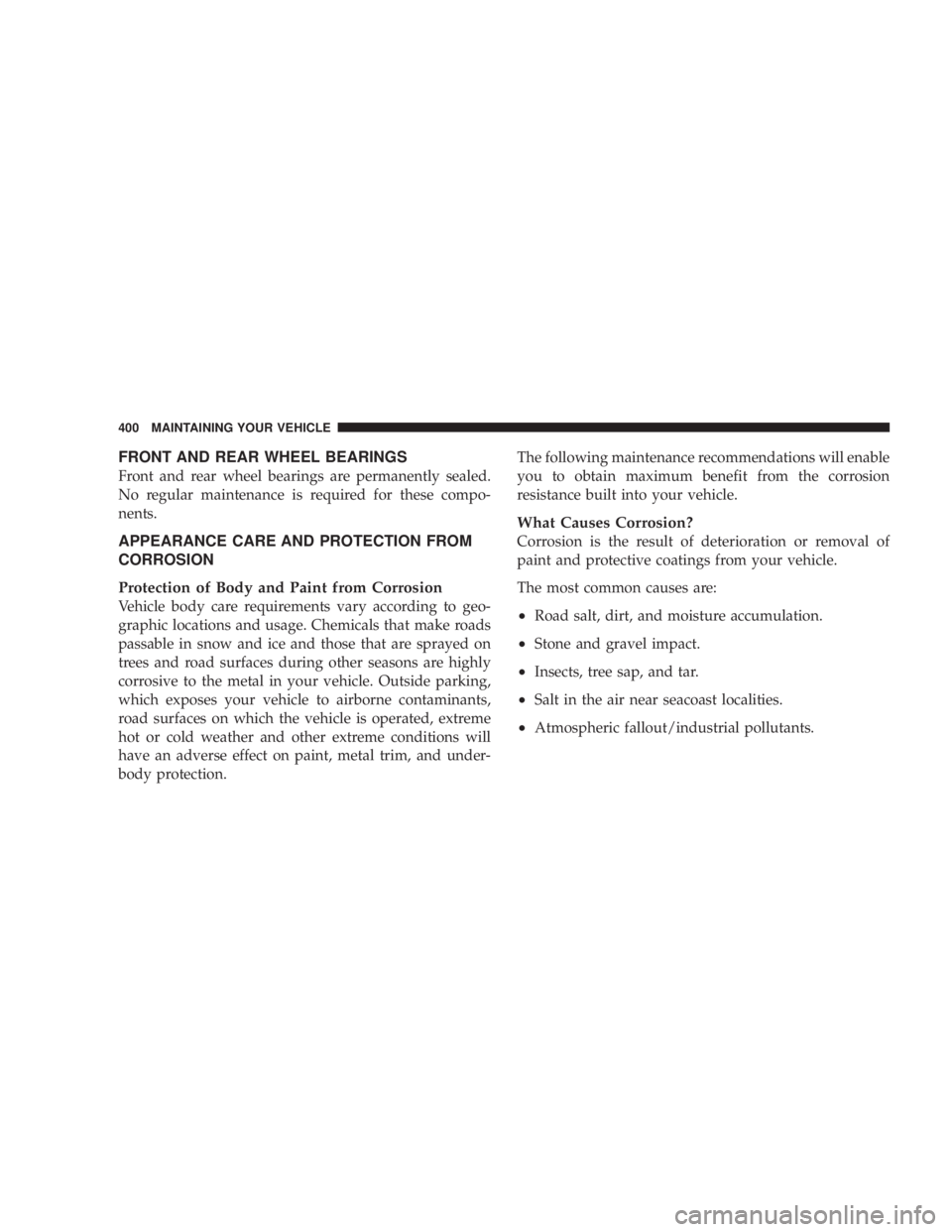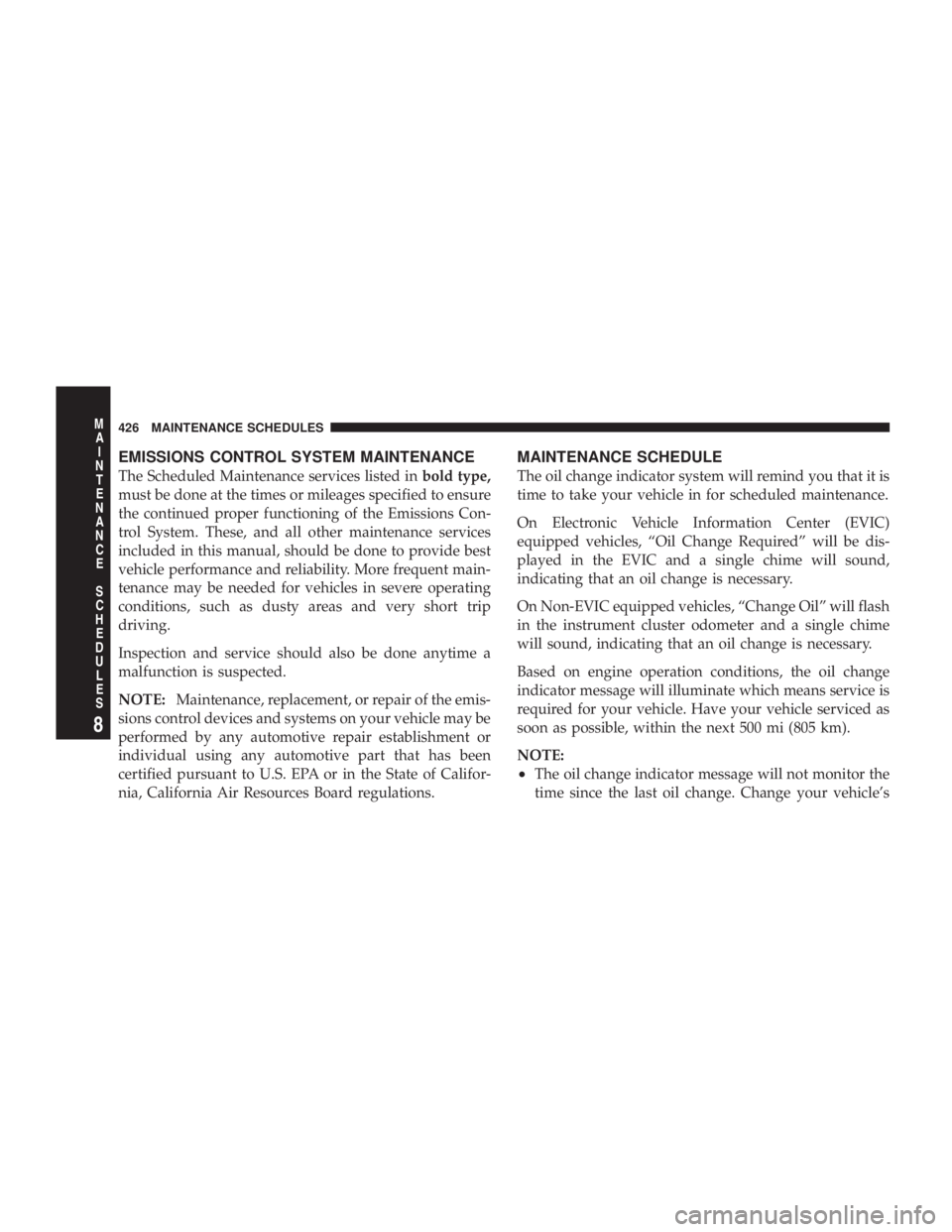Page 351 of 467
NOTE: There are steps that you can take to slow down
an impending overheat condition. If your air conditioner
is on, turn it off. The air conditioning system adds heat to
the engine cooling system and turning off the A/C
removes this heat. You can also turn the Temperature
control to maximum heat, the Mode control to floor, and
the fan control to High. This allows the heater core to act
as a supplement to the radiator and aids in removing heat
from the engine cooling system. CAUTION!Driving with a hot cooling system could damage
your vehicle. If temperature gauge reads ªHº, pull
over and stop the vehicle with the engine at idle,
when safe. Turn the air conditioner off and wait until
the pointer drops back into the normal range. After
appropriate action has been taken, if the pointer
remains on the ªHº, turn the engine off immediately,
and call for service. WHAT TO DO IN EMERGENCIES 349
6
Page 367 of 467
MAINTAINING YOUR VEHICLECONTENTS m 2.4L Engine Compartment ................368
m 2.7L Engine Compartment ................369
m 3.5L Engine Compartment ................370
m Onboard Diagnostic System Ð OBD II ........371
N Loose Fuel Filler Cap Message ............371
m Emissions Inspection And Maintenance
Programs .............................372
m Replacement Parts ......................373
m Authorized Dealer Service ................374 m Maintenance Procedures ..................374
N Engine Oil ..........................374
N Engine Oil Filter ......................378
N Drive Belt ...........................378
N Spark Plugs .........................379
N Engine Air Cleaner Filter ................379
N Catalytic Converter ....................379
N Maintenance-Free Battery ................381
N Air Conditioner Maintenance .............382
7
Page 384 of 467
CAUTION!² It is essential when replacing the cables on the
battery that the positive cable is attached to the
positive post and the negative cable is attached to
the negative post. Battery posts are marked posi-
tive (+) and negative (-) and identified on the
battery case. Cable clamps should be tight on the
terminal posts and free of corrosion. Apply grease
to posts and clamps after tightening.
² If a ªfast chargerº is used while the battery is in
the vehicle, disconnect both vehicle battery cables
before connecting the charger to battery. Do not
use a ªfast chargerº to provide starting voltage as
battery damage can result. AIR CONDITIONER MAINTENANCE
For best possible performance, your air conditioner
should be checked and serviced by an authorized dealer
at the start of each warm season. This service should
include cleaning of the condenser fins and a performance
test. Drive belt tension should also be checked at this
time.382 MAINTAINING YOUR VEHICLE
Page 385 of 467

WARNING!² Use only refrigerants and compressor lubricants
approved by the manufacturer for your air condi-
tioning system. Some unapproved refrigerants are
flammable and can explode, injuring you. Other
unapproved refrigerants or lubricants can cause
the system to fail, requiring costly repairs. Refer to
Section 3 of the Warranty Information book for
further warranty information.
² The air conditioning system contains refrigerant
under high pressure. To avoid risk of personal
injury or damage to the system, adding refrigerant
or any repair requiring lines to be disconnected
should be done by an experienced technician. Refrigerant Recovery and Recycling
R-134a Air Conditioning Refrigerant is a hydrofluoro-
carbon (HFC) that is endorsed by the Environmental
Protection Agency and is an ozone-saving product. How-
ever, the manufacturer recommends that air conditioning
service be performed by authorized dealers or other
service facilities using recovery and recycling equipment.
NOTE: Use only manufacturer approved A/C System
Sealers, Stop Leak Products, Seal Conditioners, Compres-
sor Oil, and Refrigerants.
A/C AIR FILTER Ð IF EQUIPPED
Refer to the ªMaintenance Scheduleº in Section 8 of this
manual for A/C Air Filter service intervals.
WARNING!Do not remove the A/C Air Filter while the blower is
operating or personal injury may result. MAINTAINING YOUR VEHICLE 383
7
Page 395 of 467

humidity accumulating on the radiator and being vapor-
ized when the thermostat opens, allowing hot coolant to
enter the radiator.
If an examination of your engine compartment shows no
evidence of radiator or hose leaks, the vehicle may be
safely driven. The vapor will soon dissipate.
² Do not overfill the coolant recovery bottle.
² Check coolant freeze point in the radiator and in the
coolant recovery bottle. If antifreeze needs to be
added, contents of coolant recovery bottle must also be
protected against freezing.
² If frequent coolant additions are required, or if the
level in the coolant recovery bottle does not drop when
the engine cools, the cooling system should be pres-
sure tested for leaks. ² Maintain coolant concentration at 50% HOAT engine
coolant (minimum) and distilled water for proper
corrosion protection of your engine, which contains
aluminum components.
² Make sure that the radiator and coolant recovery
bottle overflow hoses are not kinked or obstructed.
² Keep the front of the radiator clean. If your vehicle is
equipped with air conditioning, keep the front of the
condenser clean, also.
² Do not change the thermostat for summer or winter
operation. If replacement is ever necessary, install
ONLY the correct type thermostat. Other designs may
result in unsatisfactory coolant performance, poor gas
mileage, and increased emissions. MAINTAINING YOUR VEHICLE 393
7
Page 402 of 467

FRONT AND REAR WHEEL BEARINGS
Front and rear wheel bearings are permanently sealed.
No regular maintenance is required for these compo-
nents.
APPEARANCE CARE AND PROTECTION FROM
CORROSION
Protection of Body and Paint from Corrosion
Vehicle body care requirements vary according to geo-
graphic locations and usage. Chemicals that make roads
passable in snow and ice and those that are sprayed on
trees and road surfaces during other seasons are highly
corrosive to the metal in your vehicle. Outside parking,
which exposes your vehicle to airborne contaminants,
road surfaces on which the vehicle is operated, extreme
hot or cold weather and other extreme conditions will
have an adverse effect on paint, metal trim, and under-
body protection. The following maintenance recommendations will enable
you to obtain maximum benefit from the corrosion
resistance built into your vehicle.
What Causes Corrosion?
Corrosion is the result of deterioration or removal of
paint and protective coatings from your vehicle.
The most common causes are:
² Road salt, dirt, and moisture accumulation.
² Stone and gravel impact.
² Insects, tree sap, and tar.
² Salt in the air near seacoast localities.
² Atmospheric fallout/industrial pollutants.400 MAINTAINING YOUR VEHICLE
Page 428 of 467

EMISSIONS CONTROL SYSTEM MAINTENANCE
The Scheduled Maintenance services listed in bold type,
must be done at the times or mileages specified to ensure
the continued proper functioning of the Emissions Con-
trol System. These, and all other maintenance services
included in this manual, should be done to provide best
vehicle performance and reliability. More frequent main-
tenance may be needed for vehicles in severe operating
conditions, such as dusty areas and very short trip
driving.
Inspection and service should also be done anytime a
malfunction is suspected.
NOTE: Maintenance, replacement, or repair of the emis-
sions control devices and systems on your vehicle may be
performed by any automotive repair establishment or
individual using any automotive part that has been
certified pursuant to U.S. EPA or in the State of Califor-
nia, California Air Resources Board regulations. MAINTENANCE SCHEDULE
The oil change indicator system will remind you that it is
time to take your vehicle in for scheduled maintenance.
On Electronic Vehicle Information Center (EVIC)
equipped vehicles, ªOil Change Requiredº will be dis-
played in the EVIC and a single chime will sound,
indicating that an oil change is necessary.
On Non-EVIC equipped vehicles, ªChange Oilº will flash
in the instrument cluster odometer and a single chime
will sound, indicating that an oil change is necessary.
Based on engine operation conditions, the oil change
indicator message will illuminate which means service is
required for your vehicle. Have your vehicle serviced as
soon as possible, within the next 500 mi (805 km).
NOTE:
² The oil change indicator message will not monitor the
time since the last oil change. Change your vehicle's426 MAINTENANCE SCHEDULES
8 M
A
I
N
T
E
N
A
N
C
E
S
C
H
E
D
U
L
E
S
Page 431 of 467

Required Maintenance Intervals
Perform Maintenance Every (Where time and mileage
are listed, follow the interval that occurs first.)
Maintenance Items Miles Kilometers or Months
Change the engine oil and engine oil filter. 6,000 10 000 6
Rotate the tires. 6,000 10 000 6
If using your vehicle in dusty or off-road conditions,
inspect the engine air cleaner filter, and replace if nec-
essary. 12,000 20 000 12
Inspect the brake linings, and replace if necessary. 12,000 20 000 12
Replace the air conditioning filter (if equipped). 12,000 20 000 12
Inspect the Constant Velocity (CV) joints. Perform the
first inspection at 12,000 mi (20 000 km) or 12 months. 24,000 40 000 24
Inspect the exhaust system. Perform the first inspec-
tion at 12,000 mi (20 000 km) or 12 months. 24,000 40 000 24
Inspect the front suspension, tie rod ends and boot
seals, and replace if necessary. 24,000 40 000 24
Replace the engine air cleaner filter. 30,000 50 000 30 MAINTENANCE SCHEDULES 429
8 M
A
I
N
T
E
N
A
N
C
E
S
C
H
E
D
U
L
E
S